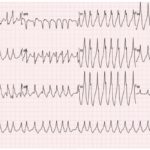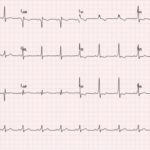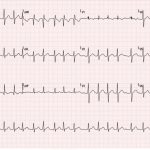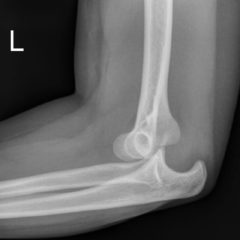Wolff-Parkinson-White Syndrome: Electrocardiogram
History of present illness:
A 26-year-old male with no significant past medical history presented to the emergency department with palpitations. The patient experienced these symptoms five times before in his life, but they had self-resolved with squatting or raising his arms. He denied chest pain, shortness of breath, dizziness, syncope, or pre-syncope symptoms. He denied any recent illnesses, cough, chest pain, drug use, or infections.
Significant findings:
The initial EKG showed wide complex, irregular tachycardia > 200 bpm (EKG 1). Given the possibility of Wolff-Parkinson-White (WPW), procainamide was given to the patient. The patient’s heart rate responded and decreased to 120-140 bpm with narrowing of the QRS complex. A repeat EKG showed narrow complex tachycardia without P waves approximately 120 bpm (EKG 2). Once the procainamide infusion was complete, the patient had converted to sinus rhythm with a delta wave now apparent, consistent with WPW (EKG 3).
Discussion:
Wolff-Parkinson-White syndrome is a combination of the presence of a certain congenital accessory pathway (Bundle of Kent) and episodes of tachyarrhythmia.1 The incidence is less than one percent of the general population,2 but it is associated with the risk of sudden cardiac death, making the diagnosis imperative. When examining a wide-based tachycardia, it is important to consider WPW when choosing medications for rate control or chemical cardioversion. The first EKG shows an example of atrial fibrillation with WPW. While procainamide blocks the accessory pathway, other drugs such as beta blockers and calcium channel blockers can inhibit the AV node resulting in increased use of the accessory pathway. This can worsen the tachyarrhythmia and potentially lead to ventricular fibrillation, ventricular tachycardia, or asystole.
Topics:
Wolff-Parkinson-White syndrome, wide complex tachycardia, cardiology, EKG, electrocardiogram, arrhythmia, cardioversion.
References:
- Burns E. Pre-excitation syndromes. Life in the Fast Lane Medical Blog. http://lifeinthefastlane.com/ecg-library/pre-excitation-syndromes.Published May 31, 2016. Accessed July 18, 2016.
- Di Biase L, Walsh E.Epidemiology, clinical manifestations, and diagnosis of the Wolff-Parkinson-White syndrome. In: Downey BC, ed. Waltham, MA: UpToDate Inc. https://www.uptodate.com/contents/wolff-parkinson-white-syndrome-anatomy-epidemiology-clinical-manifestations-and-diagnosis. Updated May 26, 2016. Accessed July 18, 2016.
- Colavita PG, Packer DL, Pressley JC, Ellenbogen KA, O’Callaghan WG, Gilbert MR, et al. Frequency, diagnosis and clinical characteristics of patients with multiple accessory atrioventricular pathways. Am J Cardiol.1987;59:601-606. doi: 10.1016/0002-9149(87)91177-5






